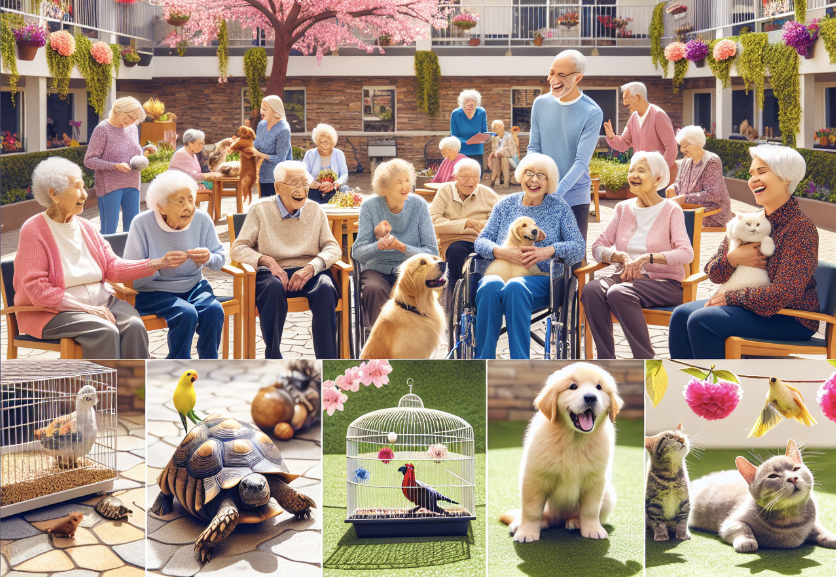Pet therapy, also known as animal-assisted therapy, is a practice that provides emotional or physical benefits through interactions with domesticated animals. It is a diverse type of therapy that involves facilitating human interactions with animals as part of a therapy approach, particularly for seniors. Pet therapy can involve activities such as snuggling with a personal pet, structured interactions with a therapy animal, or owning a specially trained pet.
Pet therapy has been shown to have numerous health benefits, including reducing stress, loneliness, and symptoms of depression and anxiety in seniors. It can also help increase serotonin and endorphin levels while lowering cortisol, leading to improved mental health and overall well-being. Additionally, pet therapy can encourage physical activity through activities like dog walking, which can help lower blood pressure and promote healing and recovery.
Understanding Pet Therapy
Pet therapy, also known as animal-assisted therapy (AAT), is a goal-oriented intervention that utilizes animals to help individuals cope with health challenges and social isolation. It involves the presence of trained animals in care settings to promote physical, emotional, and cognitive well-being. Therapy animals are classified into three types:
- Therapeutic visitation animals: Household pets taken to various facilities to provide comfort and joy.
- Animal-assisted therapy animals: Work with physical and occupational therapists in rehabilitation settings.
- Facility therapy animals: Often found in nursing homes or assisted living facilities, assisting residents with Alzheimer’s, dementia, or other mental illnesses.
Pet therapy can be categorized into three types: animal-assisted therapy, visitation therapy, and ownership therapy. AAT is a formal, structured interaction between a person and a trained animal with the purpose of helping someone recover from or cope with a health problem or mental disorder. It is often confused with animal-assisted activities (AAA), which are more casual meetings in which an animal and its handler interact with one or more people for comfort or recreation.
Almost any tame, friendly animal can be used for pet therapy, not just dogs. Animals used in pet therapy include dogs, cats, horses, birds, and rabbits, which are evaluated and trained for obedience and comfort in care settings. Before an animal and its handler can participate in pet therapy, the team has to fulfill certain requirements, including a physical examination of the animal, an obedience training course, an instructional course to teach the trainer about interaction with other people, an evaluation of the animal’s temperament and behavior with the handler, and a certification from the sponsoring organization.
The Benefits of Pet Therapy for Seniors
Pet therapy offers numerous benefits for seniors, improving their mental, emotional, and physical well-being. Interacting with therapy animals can help lower blood pressure, decrease heart rate, and reduce the production of stress hormones. It also promotes the release of endorphins, serotonin, prolactin, and oxytocin, which can boost mood and reduce anxiety and depression. Pet therapy has been found to improve seniors’ mental health by increasing social interaction, reducing feelings of isolation, and providing companionship and emotional support.
Moreover, pet therapy can provide mental stimulation, help people with memory disorders recall specific memories, reduce loneliness, trigger the release of endorphins, reduce overall physical pain, and improve motor skills. It can also enhance communication and social skills, and provide motivation for exercise and outdoor activities. Studies have shown that pet therapy can improve well-being in the elderly living in nursing homes and offer various benefits such as cognitive stimulation, pain and stress management, and increased life satisfaction.
In healthcare settings, pet therapy can calm overwhelmed patients, such as those with dementia or undergoing medical procedures, and offer emotional support for visiting family and friends. Therapy dogs in long-term health care environments can maintain a positive attitude, fulfill the human need for touch, eliminate language barriers, and stimulate the mind. Overall, pet therapy has been linked to lower levels of loneliness, increased life satisfaction, and smaller decreases in life satisfaction after retirement in older adults.
Types of Animals Used in Pet Therapy
While dogs are the most common therapy animals, a variety of other animals can also provide companionship and assistance in pet therapy settings. These include:
- Cats: Known for their calming presence, cats can offer comfort and emotional support to seniors in various care facilities.
- Horses: Equine-assisted therapy involves interactions with horses, which can help improve balance, coordination, and emotional well-being.
- Rabbits: Gentle and easy to handle, rabbits can provide a soothing presence and encourage social interaction among seniors.
- Birds: Birds, such as parrots or canaries, can offer companionship and mental stimulation through their singing and playful behavior.
- Guinea Pigs: These small, friendly creatures can be held and petted, providing tactile stimulation and promoting a sense of nurturing in seniors.
Other animals, such as fish, hamsters, and even llamas or alpacas, may also be used in pet therapy programs, depending on the setting and the specific needs of the individuals involved. The choice of therapy animal often depends on factors such as the animal’s temperament, the facility’s resources, and the preferences of the seniors participating in the therapy sessions.
Implementing Pet Therapy in Senior Care
Implementing pet therapy in senior care settings requires careful planning and collaboration among care providers, therapy animal organizations, and trained professionals. A needs assessment should be conducted to determine the specific goals and requirements of the pet therapy program, followed by establishing partnerships with reputable therapy animal organizations that can provide trained animals and handlers.
When introducing a pet therapy program, consider the following steps:
- Choose the right pets: Select animals with calm temperaments and good health, such as dogs, cats, or rabbits.
- Consult relatives: Involve family members in the decision-making process to ensure their support and address any concerns.
- Ask about allergies: Check with residents and staff for any pet allergies to avoid potential health issues.
- Hire a pet therapist: Work with a professional company that provides certified therapy animals and experienced handlers.
Pet therapy activities in care settings can include:
- Animal-assisted visits
- Animal feeding and grooming
- Walking or exercising animals
- Training sessions
- Reading or storytelling with animals
However, implementing pet therapy in senior care also comes with challenges, such as:
- Accessibility issues
- Allergies among residents or staff
- Cost of maintaining therapy animals
- Training and liability concerns
- Emotional attachment and potential loss
- Health concerns related to animal-borne illnesses
- Lack of awareness about pet therapy benefits
- Time constraints for staff and volunteers
Despite these challenges, pet therapy is increasingly being offered as part of health and wellness programs in senior care communities, such as those operated by Elder Care Alliance. By providing social support and reducing the risk of loneliness, pet therapy can significantly improve the quality of life for older adults in various care settings.
Challenges and Considerations
While pet therapy offers numerous benefits for seniors, it is essential to consider the challenges and potential drawbacks associated with implementing such programs in senior care settings. Infection prevention and control is a significant concern, as animals can carry and transmit diseases to humans, particularly in healthcare environments where individuals may have compromised immune systems. Maintaining proper hygiene practices, such as hand washing and regular cleaning of animal areas, is crucial to minimize the risk of infection.
Another challenge lies in sustaining the implementation and benefits of pet therapy interventions over time. Inconsistent research methodology, lack of standardized control groups and intervention protocols, and the presence of confounding variables can make it difficult to draw definitive conclusions about the long-term effectiveness of pet therapy. Additionally, short timelines, small sample sizes, high dropout rates due to death, relocation, or reluctance to continue, and samples drawn from the same facility can limit the generalizability of research findings.
When considering pet therapy for seniors, it is important to address safety concerns, such as the risk of injury from animal bites or scratches, and the potential for allergic reactions. The costs associated with pet therapy, including the initial purchase or adoption fee, ongoing expenses related to pet ownership, and the cost of therapy sessions, should also be taken into account. Other potential harms to consider include damage to property or the environment, zoonotic infections, adverse psychological events (e.g., grief reaction over loss of pet), and adverse social events (e.g., friends or neighbors fearing the pet). Proper handling and hygiene practices, as well as clear communication with treating healthcare professionals, are essential to maintain the well-being of both the therapy animals and the elderly individuals involved in pet therapy programs.
Conclusion
Pet therapy has emerged as a promising approach to improve the lives of seniors, offering a wide range of physical, emotional, and mental health benefits. By interacting with specially trained animals, older adults can experience reduced stress, loneliness, and symptoms of depression and anxiety while enjoying increased social interaction and companionship. The diverse array of animals used in pet therapy, from dogs and cats to horses and rabbits, allows for tailored interventions that cater to the unique needs and preferences of each individual.
However, implementing pet therapy in senior care settings requires careful consideration of potential challenges, such as infection control, sustainability, safety concerns, and associated costs. By addressing these issues through proper hygiene practices, clear communication, and collaboration with experienced therapy animal organizations, senior care providers can successfully integrate pet therapy into their health and wellness programs. Ultimately, the power of the human-animal bond has the potential to significantly enhance the quality of life for older adults, making pet therapy a valuable addition to comprehensive senior care.
FAQs
What are the benefits of seniors owning pets? Owning a pet can significantly enhance the quality of life for older individuals, particularly those living alone or in group homes. Pets contribute to stress reduction, lower blood pressure, and increased opportunities for social interaction and physical activity. Overall, pet ownership supports a range of health benefits and may contribute to better health outcomes for the elderly.
How does pet therapy contribute to the mental health of older adults? Pet therapy, particularly involving dogs, has been shown to alleviate symptoms of depression in the elderly, according to a study in Psychogeriatrics. The presence of dogs tends to elicit positive emotional responses and encourages social interaction, thereby improving mental well-being in seniors residing in care facilities.
Is it advisable for someone who is 70 years old to get a dog? Yes, it is generally beneficial for seniors, including those who are 70 years old, to own a dog. Research indicates that dog owners among the senior population have lower blood pressure and cholesterol levels compared to those without pets. Moreover, having a dog reduces the risk of experiencing a heart attack and can increase the likelihood of survival following one.
What are two key advantages of animal-assisted therapy? Animal-assisted therapy offers a range of scientifically supported benefits. Engaging with animals has been directly linked to positive outcomes in mental and physical health, as well as enhancements in various skills. These therapeutic interactions with animals can be instrumental in fostering overall well-being and recovery in patients.












